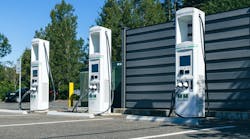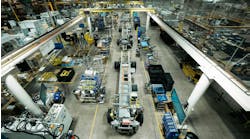In a December interview with leaders from Rush Enterprises, a national commercial truck dealer, the company’s COO, Michael McRoberts, told a group of truck media that not all of his customers are rushing at the opportunity to purchase electric trucks.
There are multiple reasons for the lack in motivation, but one area where fleets are concerned is charging.
Fleets can’t even consider EVs without planning how to charge them. And unless they install their own charging infrastructure at their facilities, they might find keeping juice in their EV batteries to be quite the challenge.
One might think public charging is sufficient, but a look at the numbers tells a different story. There are currently just over 140,000 public charging ports in the U.S., according to the most recent data from the Department of Energy. When it comes to gasoline and diesel fueling stations, there are 118,678 convenience stores, 13,346 fuel kiosks, and 6,648 big-box retail sites with fueling stations, according to the National Association of Convenience Stores—each with multiple pumps and able to fill a tank in a mere fraction of the time it takes to charge an EV battery to full capacity.
In a fall webinar hosted by Samsara, a cloud-based fleet management platform, Stephan Schablinski of DHL said the company had no choice but to install their own charging infrastructure because public chargers just weren’t sufficient.
The need for public EV charging infrastructure is dire for the adoption of zero-emission vehicles both for fleets and for personal use. Although the number of charging ports nationwide is low, the good news is that the number of public and private EV charging ports nearly doubled from 2019 to 2023, according to the Office of Energy Efficiency and Renewable Energy. Further investments from the federal government and state governments will help build out the charging infrastructure necessary for an EV transition, and those investments continue to grow.
“As major manufacturers continue to roll out medium- and heavy-duty EVs, the need for charging infrastructure equipment becomes more urgent," Alyssa Haerle, CALSTART director of infrastructure incentive administration, told FleetOwner.
Two major investments in EV charging infrastructure and hydrogen fueling stations were recently announced by the Biden Administration and the California Energy Commission.
See also: Bosch doubles down on hydrogen as key to trucking's sustainable future
Investments totaling $723 million toward ZEV infrastructure
To build out at least 500,000 public electric vehicle chargers by 2030, the Biden-Harris Administration announced $623 million in grants to fund charging infrastructure programs across the nation. This funding will come from a portion of the Bipartisan Infrastructure Law’s $2.5 billion Charging and Fueling Infrastructure Discretionary Grant Program, which will help fund 47 EV charging and alternative-fueling infrastructure projects in 22 states and Puerto Rico. This also includes the construction of approximately 7,500 EV charging ports.
“This funding will help ensure that EV chargers are accessible, reliable, and convenient for American drivers while creating jobs in charger manufacturing, installation, and maintenance for American workers,” U.S. Transportation Secretary Pete Buttigieg said in a press release.
Additional funding announced includes another $311 million from the Federal Highway Administration to fund 36 community projects, including projects in two Native American communities in Arizona and Alaska. These projects will fund EV charging infrastructure and hydrogen fueling infrastructure in rural and urban communities, including locations such as multi-family housing, schools, parks, and libraries.
Another $312 million will go to 11 corridor recipients whose projects are on roadways designated as Alternative Fuel Corridors. This funding will help fill gaps in the current national charging and alternative-fueling network.
In California, the Energy Infrastructure Incentives for Zero-Emission Commercial Vehicles Project announced more than $100 million in zero-emission vehicle charging infrastructure incentives to qualified applicants. Grant recipients can use the funds to purchase and install medium- and heavy-duty zero-emission charging infrastructure as well as hydrogen refueling infrastructure to support their ZEVs.
See also: CARB's Clean Truck Check gets slight extension
Funding will also include the installation of more than 1,500 chargers and nearly 60 hydrogen dispensers.
EnergIIZE, funded by the California Energy Commission and administered by CALSTART, is the nation’s first incentive program for commercial vehicle fleet infrastructure. It offers four standard funding opportunities that include EV Fast Track, with application acceptance beginning on February 7; Hydrogen, which opens in April; EV Jump Start; and EV Public Charging Station. EnergIIZE will also provide funding to complement the California Air Resources Board’s Hybrid and Zero-Emission Truck and Bus Voucher Incentive Program awardees for bus and drayage fleet vehicles. This includes public school buses, transit, and drayage.
“Catalyzing the ZEV market is key to reaching our net-zero climate goals and will spur quicker development of EV charging and hydrogen refueling equipment throughout the country,” said Alyssa Haerle, director of infrastructure incentive administration at CALSTART.
Meeting a need for both fleets and individuals
Funding from both the federal government and the state of California is designed to help communities affected by harmful emissions transition to electric vehicles.
“Every community across the nation deserves access to convenient and reliable clean transportation,” said U.S. Secretary of Energy Jennifer M. Granholm in a statement. This funding, along with other funding from the Infrastructure Law set aside for the electric vehicle and alternative fuel transition, will bring “an accessible, made-in-America charging network into thousands of communities while cutting the carbon pollution that is driving the climate crisis.”
This funding will also help address one of the concerns preventing businesses and individuals from purchasing EVs: the lack of charging stations.
“From my time working at the local level, I know that finding electric vehicle charging in a community is different from finding charging along highways,” said U.S. Transportation Deputy Secretary Polly Trottenberg in a press release. This investment will “make an investment that will provide Americans with convenient, straightforward charging options in their communities.”
Federal funding for public EV charging access is being provided for seven projects across the country. One project awarded to the North Central Texas Council of Governments will fund the building of up to five hydrogen fueling stations for medium- and heavy-duty freight trucks in Dallas, Austin, Houston, and San Antonio to create a hydrogen corridor from southern California to Texas.
Contrary to what Rush Enterprises’ COO heard from one of his customers—that he isn’t at all interested in purchasing an electric vehicle for his fleet—Sanjit Biswas, CEO and co-founder of Samsara said in a webinar that almost all of Samsara’s customers are showing an interest in EVs, and roughly 50% of them are considering EV adoption within the next two years. With these investments in charging infrastructure, Biswas just might see that happen.




